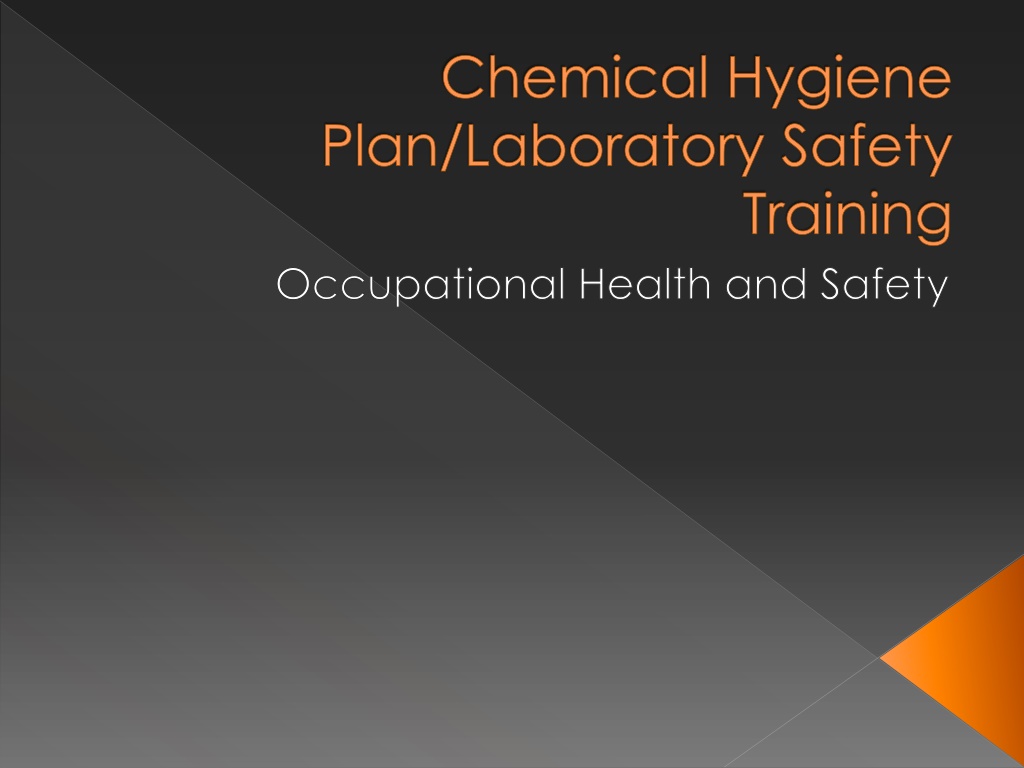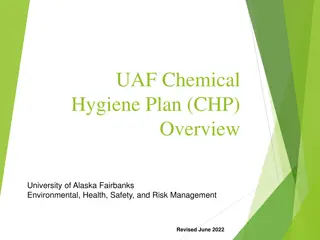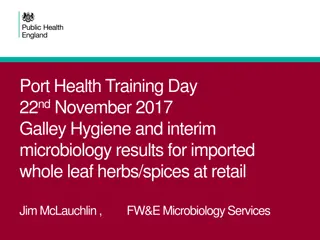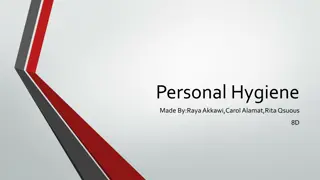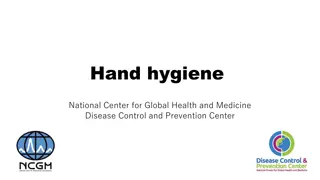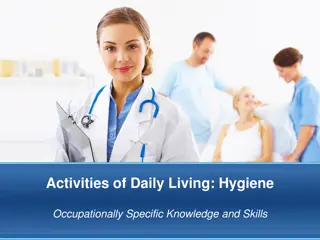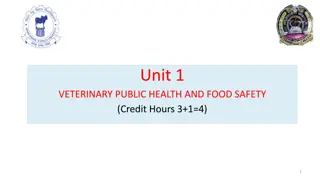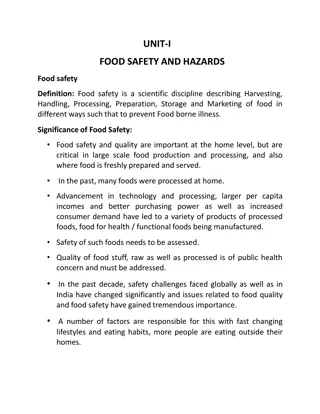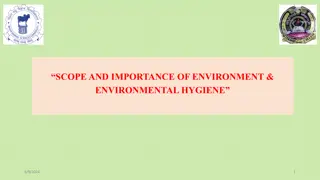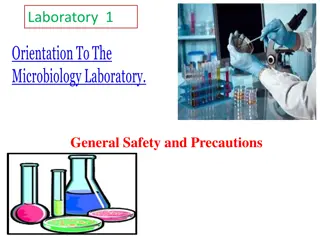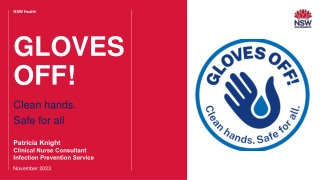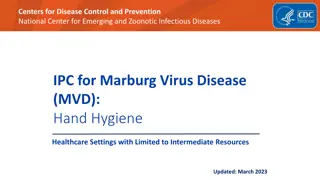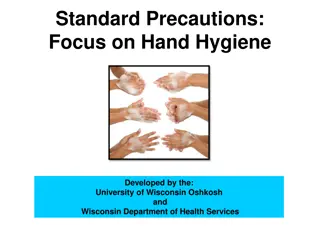Chemical Hygiene Plan & Laboratory Safety Overview
This document outlines the Chemical Hygiene Plan and Laboratory Safety procedures, including responsibilities, standard operating procedures, controlling chemical exposures, and the use of engineering controls like chemical fume hoods. It serves as a guide for maintaining a safe working environment in laboratories and ensuring compliance with occupational health and safety standards.
Uploaded on Sep 25, 2024 | 0 Views
Download Presentation

Please find below an Image/Link to download the presentation.
The content on the website is provided AS IS for your information and personal use only. It may not be sold, licensed, or shared on other websites without obtaining consent from the author. Download presentation by click this link. If you encounter any issues during the download, it is possible that the publisher has removed the file from their server.
E N D
Presentation Transcript
Chemical Hygiene Plan/Laboratory Safety Training Occupational Health and Safety
Table of Contents Introduction Responsibilities Standard Operating Procedures/Standard Practices Controlling Chemical Exposures Chemical Fume Hoods and Other Engineering Controls Employee Information and Training Prior Approval Medical Consultation Special Provisions for Select Carcinogens, Reproductive Toxins and Toxic Chemicals
Introduction The Chemical Hygiene Plan is part of the University s compliance with the regulations promulgated on Jan. 31. 1990 by the U.S. Department of Labor Occupational Health and Safety Administration (OSHA). This Standard entitled, Occupational Exposures to Hazardous Chemicals in Laboratories is hereafter referred to as the Lab Standard.
Responsibilities of Chemical Hygiene Plan Standard Operating Procedures Criteria to determine and implement specific control measures, such as engineering controls and personal protective equipment A program that ensures that fume hoods and other engineering controls are functioning properly Information and training requirements When a lab will require prior approval Provisions for medical consultation and medical exams Designation of the Chemical Hygiene Officer Additional precautions for select carcinogens, reproductive toxins and extremely toxic substances.
Covered by standard Everyone is covered by the standard that works in a laboratory. Laboratory is defined by OSHA as, a workplace where relatively small quantities of hazardous chemicals are used on a non-production basis. Laboratory workers should be 18 years or older. For students age 17 and under, prior approval is needed through the Minors in Lab Policy
Training Requirements Before commencement of lab duties, all laboratory workers must read the Chemical Hygiene Plan. Training records should be kept with either the Principal Investigator (PI) or the lab supervisor. The chemical Hygiene Plan must be reviewed annually by the Laboratory s Chemical Hygiene Officer and the revised date must be listed on the identification page.
Training Requirements continued At a minimum, the following classes must be taken for ALL laboratory personnel. Chemical Hygiene Plan/Laboratory Safety Chemical Hygiene Plan Annual Refresher Hazardous Waste Fire Extinguisher Training If other hazards are present in the lab, such as biological or radiological agents, training must be conducted in these areas as well. Below is a link to Environmental Health and Safety Training Checklist
Responsibilities associated with Laboratory Safety and the Chemical Hygiene Plan Environmental Health and Safety Department s Responsibilities Appoint an Institutional Chemical Hygiene Officer who will routinely review the model Chemical Hygiene Plan and suggest modifications as needed Provide technical assistance to Laboratory Supervisors and workers concerning appropriate storage, handling and disposal of hazardous chemicals Provide general laboratory safety training upon request Conduct exposure assessments and laboratory inspections upon request and on a routine basis Provide technical assistance concerning personal protective equipment and laboratory safety equipment Remain current on rules and regulations concerning chemicals used on campus
Responsibilities of Deans, Directors and Heads of Academic and Administrative Units Collaborate with faculty and staff to adapt the Model Chemical Hygiene Plan to include lab-specific guidelines and to develop strategies to implement the Plan Consider the idea of developing departmental-wide laboratory safety training programs and/or committees Make budget arrangements for health and safety improvements. It is the responsibility of these respective individuals to request the necessary monies in the budget process
Responsibilities of Faculty and Staff Inform and train employees concerning chemical safety as required by this Plan. Retain training records and all documentation. Implement and enforce rules and standard of this plan concerning health and safety for laboratories under the supervisor s jurisdiction and restrict access to the laboratory Serve as the Chemical Hygiene Officer for the laboratory Ensure compliance of laboratory workers in the Plan
Faculty and Staff Responsibilities continued Ensure the availability and enforce the proper use of appropriate personal protective equipment and relevant health and safety reference materials Remain cognizant of chemicals stored and used in labs and their associated hazards Develop an annual inventory of chemicals present in the laboratory (E-trax electronic system) Conduct internal inspections for health and safety concerns and maintain an inspection log Request assistance from Environmental Health and Safety, as needed Request allocation of funds from superiors for health and safety improvements
Laboratory Worker Responsibilities Follow all health and safety standards and rules Report all hazardous conditions to the laboratory supervisor Wear or use prescribed protective equipment Report any suspected job-related injuries or illnesses to the laboratory supervisor and seek treatment immediately Refrain from the operation of any equipment or instrumentation without proper instruction and authorization Remain aware of the hazards of the chemicals in the lab and how to handle hazardous chemical safely Request information and training when unsure how to handle a hazardous chemical or procedure
Standard Operating Procedures (SOPs)
Standard Operating Procedures/ General Practices The Lab Standard requires operating procedures relevant to safety and health consideration to be followed when laboratory work involves the use of hazardous chemicals.
General SOPs/Standard Practices Authorized Access The Laboratory Supervisor must restrict access to laboratories. Children (under age 17) are not allowed in the laboratories except as authorized by the Laboratory Supervisor for an officially sanctioned activity (e.g. class or open house or approved Minor s in lab form). Pets are also prohibited from laboratories. Containers - Check the integrity of containers and if damaged or leaking, transfer to an acceptable container or call Environmental Management for assistance (323-6280). For disposal, submit an E-trax electronic ticket to Environmental Management. Observe compatibility; for example, hydrofluoric acid must not be stored in glass and some oxidizers should not be stored in plastic containers.
General SOPs/Standard Practices Compressed Gas Cylinder Handling--Use appropriate handcarts to move cylinders. Cylinders must be secured at all times. Extremely toxic gases (e.g. hydrogen sulfide, chlorine, arsine) should not be moved through regular exit corridors, particularly during business hours. Always consider cylinders as full and handle them with corresponding care. NOTE: For additional information on cylinder handling, go to the Compressed Gas Cylinders Guide.
General SOPs/Standard Practices Door View Panel Lab view panels should not be covered. Equipment Use proper equipment that is in good condition. For example, never use chipped or cracked glassware. Shield pressurized or vacuum apparatus and safeguard against bumping or overheating. Glass Tubing When inserting tubing into stoppers, lubricating tubing as well as wearing gloves or wrapping in a thick cloth will help protect hands from being cut in the event of the tubing slipping and breaking.
General SOPs/Standard Practices Disposal of Waste It is important to segregate wastes. To request pick-up of hazardous waste, biohazardous waste or chemicals, fill out an E-trax electronic ticket. Disposal of all laboratory waste must follow the procedures specified by Environmental Management (323-6280). To request pick-up of radioactive wastes, contact Radiation Safety at 323-6780.
General SOPs/Standard Practices Food, Drink, Cosmetics. Eating, drinking and the application of cosmetics (including lip balm) is forbidden in areas where hazardous chemicals are used and must be done only in well-defined designated non-chemical areas. Do not store food in the same refrigerator with chemicals, biohazards or radioactive materials. Refrigerators, microwaves and ice machines must have labels that denote their use, i.e. "Not for food or drink
General SOPs/Standard Practices Hazardous Materials Hazardous materials should not be used on open laboratory benches. Horseplay Horseplay, practical jokes or other inappropriate and unprofessional behavior in the laboratory setting is forbidden. Avoid distracting or startling other workers. Housekeeping Exits, aisles and safety equipment must NOT be obstructed in any way with equipment, furniture, etc. No items must be stored in the corridors. For questions related to the use of corridors or any exiting or Fire Marshal issue, contact the Fire Marshal (257-8590).
General SOPs/Standard Practices Mercaptans To avoid false reporting of natural gas leaks, the Physical Plant department should be contacted when mercaptans are used in a laboratory in such a manner that persons outside of the laboratory could smell the mercaptan and suspect a natural gas leak in the building. For more information about mercaptans please see the fact sheet .
General Sops/Standard Practices Mouth Pipetting Mouth pipetting is forbidden. Natural Gas The Natural Gas Emergency Response Procedures are designed to provide a structured means for safe evacuation and notification of affected personnel when a potential Natural Gas Emergency exists. For more information please see the natural gas fact sheet.
General SOPs/Standard Practices No Smoking. This policy exists throughout the University and applies in all laboratories. Perchloric Acid If perchloric acid is heated above ambient temperature it will give off vapors that can condense and form explosive perchlorate salts. Hence, when heating perchloric acid above ambient temperature, a specifically designed and dedicated perchloric acid fume hood with a wash down system or a local scrubbing or trapping system must be used.
General SOPs/Standard Practices Unattended Experiments Frequently, laboratory operations are carried out continuously or overnight. For experiments involving hazardous operations, it is essential to plan for interruptions in utility services such as electricity, water and inert gas. Operations are to be safe and plans made to avoid hazards in case of failure. If necessary, arrangements for routine inspection of the operation are to be made and, in all cases, the laboratory lights should be left on and an appropriate sign posted on the door.
General SOPs/Standard Practices Working Alone When working with acutely hazardous materials, it is advisable to have a second person present, or at a minimum, maintain surveillance via telephone contact.
Personal Standard Operating Procedures
Personal Protective Equipment. OSHA has amended standards for personal protective equipment (PPE) to require employers to assess the workplace to determine if there are hazards requiring the use of PPE and certify that this assessment was performed. The following generic PPE requirement for labs can be used and supplemented as appropriate. For additional hazards, contact Occupational Health and Safety Department, 7-3827.
Personal Attire Personal protection and personal hygiene are two very basic aspects of laboratory safety. Wearing appropriate personal protective equipment and practicing good personal hygiene as described below will minimize exposures to hazardous chemicals during routine use and in the event of an accident.
Personal Protective equipment (PPE) Attire Wear a lab coat or apron, cover legs and feet (no sandals or open-toed shoes), and confine loose clothing and long hair. For addition information see the PPE& Apparel In Chemical Labs Fact Sheet
PPE Gloves- Gloves are essential when working with hazardous substances. The proper gloves will prevent skin absorption, infection or burns. All gloves materials are not equally effective in protection from chemical hazards. Consult a chemical resistance chart such as the one found in the Glove selection guide, or consult a glove manufacturer. Environmental Management (323-6280) and Occupational Health and Safety (257-3827) are also available to assist with glove selection.
PPE Eye Protection It is University of Kentucky policy that personnel including students, staff, and visitors in laboratories wear appropriate safety glasses, goggles or face shields at all times, when chemicals are stored or handled. Goggles are required when chemical splashes are possible. Face Shields Full Face shields must be worn when conducting a procedure where splashing is a potential. Full face shields with bottom caps to protect under the chin are preferred due to the tendency to raise the chin when a splash occurs.
PPE Assessment Guide HAZARD ASSESSMENT AND PERSONAL PROTECTIVE EQUIPMENT REQUIREMENTS FOR GENERAL LABORATORY OPERATIONS Hazard Personal Protective Equipment Required Eye Safety glasses at all times Face Hand/Skin/Body Lab coat Any lab use of chemicals Use of corrosive chemicals, strong oxidizing agents, Chemical splash goggles Full face shield and goggles (for work with --Resistant gloves for chemical resistance of common glove Carcinogens, mutagens, etc Over 4 liters of corrosive liquid Impervious lab coat, coveralls, apron, protective suit (for work with greater than 5 gallons of corrosive liquid) Insulated gloves for handling ovens, furnaces, cryogenic bath and other devices over 100 degrees Centigrade or below -1 degrees Centigrade Temperature Extremes Heavy cloth barrier or leather gloves Sharp Objects (broken glass, rods into stoppers)
PPE Respiratory Protection The use of some substances may require the use of respiratory protection (respirators). See Controlling Chemical Exposures in this training for more information.
Good Laboratory Practices Personal Use of Chemicals Lab workers are not allowed to remove chemicals from the lab for personal use. Personal Hygiene Hands should be washed frequently throughout the day, before leaving the lab, after contact with any hazardous materials, and before eating.
Hazardous Material Handling and Storage
Hazardous Material Handling and Storage Hazards associated with various chemicals and gases vary widely. Understanding the hazards associated with a compound and minimizing the quantity used and stored in the lab will decrease chance of injury.
Chemical Spills and Accident Response As a matter of policy, University personnel should handle their own small spills and releases. For emergency situations i.e., large spills and leaks, evacuate and call 911 (Campus Police) from a safe location. See flow chart, Planning for Emergencies for more information.
Chemical Storage Chemicals ideally should be stored by compatibility, not simply by alphabetical arrangement. Oxidizers should be separated from organics, air/water reactives must be kept dry and cyanides should be stored away from acids. Volatile toxic substances must be stored in volatile storage cabinets adequate to the purpose. When volatiles must be stored in a cooled atmosphere, explosion-proof refrigerators or similar specially designed equipment must be used.
Examples of incompatible Chemicals Acetic acid with Nitric acid Bleach and Hydrochloric acid
More Examples Potassium dichromate, acetone and perchloric acid Sodium borohydride and tetrodotoxin
Flammables in Refrigerators Do not store flammable liquids in a refrigerator unless it is approved for such storage. Such Refrigerators are designed not to spark inside the refrigerator. If refrigerated storage is needed, it is advisable to choose an explosion-proof refrigerator or flammable safe refrigerator. The differences in refrigerators are explained here.
Chemical Handling Chemical Handling Encourage the use of poly coated bottles or use bottle carriers for transporting chemicals which are in regular glass containers. Close caps securely and avoid storing chemicals containers in hard to reach areas. Pour chemicals carefully, and never add water to concentrated acid. Metal containers and non- conductive containers (e.g., glass or plastic) holding more than five gallons must be grounded when transferring flammable liquids
Cylinder Storage Cylinders must be stored in well ventilated areas with their protective caps screwed on and the cylinder secured (e.g., strapped or chained in an upright position) to reduce the chance of the cylinder being knocked over. Do not store cylinders near heat or high traffic areas. Whenever possible do not store flammables and oxidizers together. Do not store empty and full cylinders together. Clearly mark empty cylinders. Storage of large quantities of cylinders must be done in an approved gas cylinder storage area. For storage and use of flammable gas cylinders, consult Office of Fire Marshal 257-6362.
Labels All chemical containers must be labeled. All labels must be legible, in English and include chemical/product name (chemical formulas alone are not acceptable) and include information related to relevant hazards. Labels on incoming containers must not be removed or defaced. Date all peroxidizable and other chemicals, which may become unstable over time (e.g. picric acid, ethers); test and/or dispose of them when appropriate. Waste chemical containers must be clearly marked as Hazardous Waste indicating specific names of waste chemicals.
GHS Labels The Globally Harmonized System of Classification and Labeling of Chemicals (GHS) GHS is an acronym for The Globally Harmonized System of Classification and Labeling of Chemicals. It is a common coherent approach to defining and classifying hazard, and communicating information on labels and safety data sheets. Its target audience includes workers, consumers, transport workers and emergency responders. It provides the underlying infrastructure for establishment of national, comprehensive chemical safety programs.
GHS Labels GHS Requirements Health, physical and environmental hazard criteria for substances and for classification of mixtures Provisions for communicating information on labels (including harmonized pictograms, hazard statements, and signals words) A 16- section safety data sheet no longer called Material Safety Data Sheets
GHS Labels GHS Label Elements Symbol (hazard pictograms): convey health, physical and environmental hazard information, assigned to a GHS hazard class and category Signal Words: Danger or Warning are used to emphasize and indicate the relative level of severity of the hazard. Hazard Statements: Standard phrases assigned to a hazard class and category that describe the nature of the hazard.
GHS Pictograms and Hazard Classes Oxidizers Flammables Self Reactives Pyrophorics Self-Heating Emits Flammable Gas Organic Peroxides Explosives Self Reactives Organic Peroxides Acute toxicity (severe) Corrosives Gases Under Pressure Carcinogen Respiratory Sensitizer Reproductive Toxicity Target Organ Toxicity Mutagenicity Aspiration Toxicity Irritant Dermal Sensitizer Acute toxicity (harmful) Narcotic Effects Respiratory Tract Irritation Environmental Toxicity
GHS Example Label ToxiFlam (Contains: XYZ) Danger! Toxic If Swallowed, Flammable Liquid and Vapor Do not eat, drink or use tobacco when using this product. Wash hands thoroughly after handling. Keep container tightly closed. Keep away from heat/sparks/open flame. - No smoking. Wear protective gloves and eye/face protection. Ground container and receiving equipment. Use explosion-proof electrical equipment. Take precautionary measures against static discharge. Use only non-sparking tools. Store in cool/well-ventilated place. IF SWALLOWED: Immediately call a POISON CONTROL CENTER or doctor/physician. Rinse mouth. In case of fire, use water fog, dry chemical, CO2, or "alcohol" foam. See Safety Data Sheet for further details regarding safe use of this product. MyCompany, MyStreet, MyTown NJ 00000, Tel: 444 999 9999
Laboratory Door Signage Requirements Room number Department Laboratory supervisor's name Emergency contacts, including names, office location, and office and emergency telephone numbers Special hazards/instructions (e.g. location of large quantities of flammables or the presence of a "local alarm" system).
